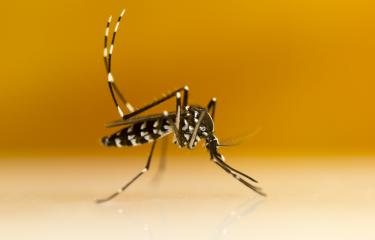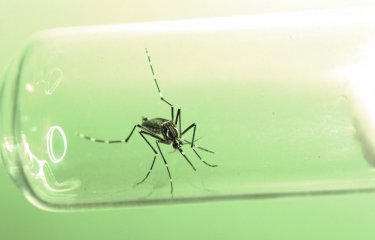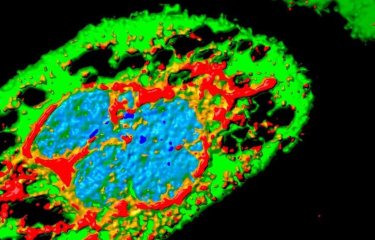The Institut Pasteur and MSDAVENIR, a health research endowment fund by MSD, signed an important partnership to anticipate responses to future vector-borne viral epidemics today. The partnership, worth more than €1.7 million, will support the INTRANZIGEANT project led by Dr. Louis Lambrechts, head of the Virus-Insect Interactions Unit, and Xavier Montagutelli, head of the Mouse Genetics Laboratory at the Institut Pasteur. This signature is the first in a new wave of investments of 42 million euros over 3 years by MSDAVENIR.
INTRANZIGEANT: interrupting virus transmission, a key scientific issue
A multidisciplinary project, INTRANZIGEANT aims to identify factors influencing the transmission cycle of arboviruses, viruses transmitted by insects such as mosquitoes, via an experimental model of Zika virus transmission.
Using the state-of-the-art genetic resources, biosafety facilities, and the scientific environment of the Institut Pasteur, the primary objective of this research project is to improve our understanding of transmission mechanisms and identify potential targets for strategies to control the spread of the Zika virus.
"Traditionally, the fight against diseases such as Zika has focused on controlling mosquitoes with insecticides, preventing infection with vaccines, or curing it with drugs. With INTRANZIGEANT, we are seeking to deepen our fundamental knowledge of a key aspect, the transmission of the virus, its passage from mosquito to man and from man to mosquito, in order to develop, at a later stage, complementary methods of control, modes of action that will make it possible to interrupt the cycle of transmission."
Doctor Louis Lambrechts, Head of the Virus-Insect Interactions Unit, Institut Pasteur
Work conducted at the Pasteur Institute has already demonstrated differences between mosquito populations, between different virus strains and differences in susceptibility depending on the recipient (i.e. the ability of the virus to replicate in a host depending on the host's genetics), indicating that genetics is a key factor in the transmission process.
Thanks to the support provided by MSDAVENIR, Dr. Lambrecht and Xavier Montagutelli's teams will have the means to test the different genetic factors, depending on the mosquitoes, the virus strains and the receptors, and which genetic combinations favor or disfavor the transmission of the Zika virus.
Furthermore, with INTRANZIGEANT, Dr. Louis Lambrechts and Xavier Montagutelli aim to develop a model to adapt to future vector-borne viral pathologies. The work done on Zika could be used as a model for any emerging disease with a pathogen.
"One of the specificities of the Zika virus lies in the complexity of understanding its propagation between 3 actors: the host agent (animal or human), the mosquito and finally the virus. By combining the expertise of the Virus-Insect Interaction Unit and the Mouse Genetics Laboratory, and with the contribution of the Institut Pasteur's high-level technological platform, we are setting up a dynamic that will allow us to better decipher the interactions between these elements and thus to better understand the spread of viruses of this type. These are viruses that we will be confronted with more and more."
Xavier Montagutelli, Head of the Mouse Genetics Laboratory, Institut Pasteur
MSDAVENIR, a strong commitment to research since 2015
The signing of this partnership with the Institut Pasteur marks the beginning of a new cycle of investments in France worth €42 million by MSDAVENIR, bringing the fund's total endowment to €117 million.
"I am pleased that MSDAVENIR is able to support the INTRANZIGEANT project at the Institut Pasteur, which addresses a public health priority. Today for the Zika virus and tomorrow perhaps for other viruses, the challenge is to better understand how emerging infectious diseases are transmitted from the animal world to humans, from a global health perspective and to better prevent them."
Clarisse Lhoste, Chairwoman of the board, MSDAVENIR fund
"Institut Pasteur welcomes MSDAVENIR's commitment and support for the INTRANZIGEANT project. This ambitious project in terms of fundamental research has the potential to contribute significantly to new progress in global public health. Institut Pasteur and MSDAVENIR thus reaffirm their determination to work together in the fight against emerging infectious diseases."
Professor Stewart Cole, President, Institut Pasteur
Since 2015, MSDAVENIR's ambition is to decompartmentalize scientific research in human health by supporting fundamental projects that are innovative in their approach and that respond to major public health issues.
The projects supported are selected by the fund's Scientific Council, leaving researchers a great deal of freedom: no specific date for the call for projects, no predefined theme, etc., while giving researchers the possibility of projecting themselves into the future and understanding their work in a global way in order to bring about breakthrough innovations for the benefit of patients and public health.
|
Emerging vector-borne diseases They are caused by previously unknown infectious agents that appear in the human population. Very often, these infectious agents come from animal reservoirs. Animals that were already carrying these pathogens and at some point transmit them to humans. The epidemic is triggered when the pathogen is transmitted from humans to humans. Among these emerging pathogens, some are transmitted by the respiratory route, but there are others that are transmitted through an insect, sometimes an arthropod such as a tick or, more often, a mosquito. For the latter, they can also transmit chikungunya, dengue or Zika virus. |
|
Zika, a virus emblematic of emerging vector-borne diseases Circulating in primates and monkeys, the Zika virus has been known for 70 years but was not problematic for human health before 2007 and its massive and global expansion during 2015 / 2016. It was at this time that serious symptoms appeared, such as the birth of babies with small heads, microcephaly, or neurological disorders like Guillain-Barré syndrome... |





